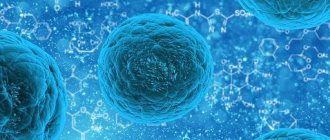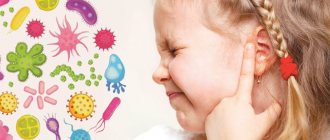Eziklen
The drug is not used to treat constipation.
Electrolyte disorders and dehydration:
Given the potential risk of developing serious electrolyte disturbances, the benefit/risk ratio should be carefully assessed before using the drug in high-risk groups. Before using the drug, contraindications for its use must be excluded. Particular attention should be paid to the use of special precautions, including the need to maintain adequate hydration.
All patients should be warned about the need to maintain adequate levels of hydration before, during and after taking the drug. If a patient develops excessive vomiting or signs of dehydration after taking the drug, rehydration measures should be taken to avoid the potential risk of serious complications associated with fluid and electrolyte imbalance (such as seizures and cardiac arrhythmias). In addition, preliminary laboratory tests are recommended (determining the concentration of electrolytes, creatinine and blood urea nitrogen). Patients should be advised to drink as much water or clear liquids as possible to maintain an appropriate level of hydration.
High-risk patients:
In malnourished, debilitated patients, elderly patients, patients with clinically significant impairment of renal, hepatic or cardiac function, and in patients at high risk of developing electrolyte disturbances, biochemical tests should be performed to determine serum electrolyte concentrations and renal function should be assessed before and after treatment. use of the drug.
Patients with dehydration or water-electrolyte imbalances should receive appropriate therapy to eliminate them before taking the drug to cleanse the intestines. In addition, caution should be exercised when using the drug in patients with medical conditions or in patients taking drugs that increase the risk of fluid and electrolyte imbalances (including hyponatremia and hypokalemia) or increase the risk of potential complications. Monitoring of such patients is necessary.
There is a theoretical risk of QT prolongation that could occur as a result of electrolyte abnormalities.
Caution must be exercised when using the drug in the following groups of patients:
The drug should be used with caution and only under the supervision of medical personnel in patients with an impaired gag reflex and in patients with a tendency to regurgitation and aspiration.
Decreased gastrointestinal motility, including a history of gastrointestinal surgery that resulted in decreased motility.
Hyperuricemia:
Taking the drug may cause a temporary mild or moderate increase in uric acid concentrations. The possibility of increased uric acid concentrations should be considered before prescribing the drug to patients with manifestations of gout or hyperuricemia.
Additional Information:
Before taking the drug must be diluted with water. Taking undiluted solution may increase the risk of nausea, vomiting, dehydration, and electrolyte disturbances. Each bottle of the drug must be diluted with water, and the recommended additional amount of water must be consumed to ensure good tolerability of the drug by the patient.
The medicinal product contains 247.1 mmol (or 5.684 g) sodium per vial. This must be taken into account in patients who are on a sodium-controlled diet.
The medicinal product contains 35.9 mmol (or 1.405 g) potassium per vial. This must be taken into account in patients with reduced renal function or in patients who are on a diet with controlled potassium intake.
Release form and composition
Dosage form - concentrate for the preparation of a solution for oral administration: transparent or slightly opalescent liquid with a fruity odor (176 ml each in transparent dark brown polyethylene terephthalate bottles with a volume of 180 ml, in a cardboard box, instructions for use of Eziklen and 2 bottles with concentrate included with measuring cup).
Composition of the drug in 1 bottle (176 ml):
- active ingredients: sodium sulfate (anhydrous) – 17.51 g; magnesium sulfate heptahydrate – 3.276 g; potassium sulfate – 3.13 g;
- auxiliary components: purified water, anhydrous citric acid, sucralose, sodium benzoate, malic acid, fruit and berry cocktail flavor (a mixture of natural and synthetic flavors, acetic and benzoic acids, ethyl alcohol, propylene glycol).
Esiclene, instructions for use: method and dosage
Esiclene concentrate diluted with water is taken orally.
Preliminary dilution of the concentrate: pour the contents of one bottle into a measuring cup and dilute with drinking water to the mark (it corresponds to a volume of 0.5 l). Within 2 hours, you need to take the diluted drug and drink two more measuring cups filled to the mark with the approved clear liquid. This can be water (including carbonated water), as well as clarified fruit juices without pulp (not red or purple), tea and coffee without milk/cream, broths or soups, strained from solid ingredients.
To properly cleanse the intestines, you need to take the contents of two bottles of Esiclene. This is possible in two ways: in fractional or one-time reception mode. The optimal regimen is chosen by the attending physician. If the time of the prescribed procedure allows, the fractional application mode is considered preferable.
Fractional mode
Esiclene is taken in the evening (for example, at 18:00) the day before the procedure, and then in the morning on the day of the study/intervention. The interval between doses should be 10–12 hours.
In this case, one bottle of concentrate is diluted in the evening. Over the next 2 hours, drink the resulting solution and two measuring cups of clear liquid.
The second bottle is diluted in the morning and taken in the same way, i.e., over the course of 2 hours, drink the diluted concentrate and two measuring cups of clear liquid.
It is necessary to stop taking the drug with additional liquid no later than 2 hours before the procedure, but not earlier than 4 hours before it starts.
One-time use
Esiclene is taken the day before the procedure.
In this case, the concentrate from 1 bottle should be diluted with water. Within 2 hours, drink the solution and two measuring cups of clear liquid. Take a break of about 2 hours and repeat the procedure according to a similar scheme.
It is necessary to stop taking the drug with additional clear liquid no later than 2 hours before the procedure, but not earlier than 4 hours before it starts.
Scheme of dilution and administration of the drug
Esiclene is diluted and taken as follows:
- Open the bottle of concentrate by pressing on the cap and turning it counterclockwise.
- Pour the contents of the bottle into the measuring cup included in the package.
- Dilute the concentrate with water to the mark on the glass.
- Drink the solution slowly over 0.5–1 hour.
- Over a period of about 1 hour after this, drink two measuring cups filled to the mark with an approved clear liquid (i.e., about 30 minutes for each glass).
Completing all stages takes approximately 2 hours.
In the simultaneous application mode, all the described points are repeated one more time.
The concentrate should be diluted with water immediately before use, since the prepared solution cannot be stored.
Power Requirements
You can eat a light breakfast the day before the procedure. For the remaining time, right up to the procedure itself, you are allowed to consume only clear liquids.
Do not drink alcohol, milk or red or purple drinks.
After the procedure
Esiclene causes diarrhea, which leads to fluid loss. In this regard, to replenish its deficiency and maintain an appropriate level of hydration after the procedure, you should drink a sufficient amount of water.
Use during pregnancy and lactation
The effects of sulfates on reproductive function have not been studied in animal studies. There are no data on the use of Esiclene in women during pregnancy, therefore its use is contraindicated during pregnancy.
It is not known whether the components of the laxative are excreted in mother's milk, but the risk to the nursing infant cannot be completely excluded. If the prescription of Esiclene is clinically justified, breastfeeding should be temporarily stopped. It can be resumed 48 hours after taking the second dose.
The effect of osmotic laxatives on fertility has not been studied.
Pharmacological properties
Pharmacodynamics
Esiclene is a combined osmotic laxative. The mechanism of its action is mainly due to the process of active transport of sulfates, which is limited in saturation. Once the saturation threshold is reached, sulfates (sodium, magnesium and potassium) remain in the intestinal lumen. When drinking large amounts of water, unabsorbed sulfates contribute to its retention in the intestines - this explains the laxative effect manifested by watery diarrhea. As a result, the intestines are cleansed.
Pharmacokinetics
Absorption of sulfate after oral administration is a saturation-limited process of active transport.
In clinical trials, a drug similar to Eziclene in terms of sulfate content was studied. Six healthy volunteers took it 2 times a day at 12-hour intervals. The maximum serum concentration (Cmax) of sulfates was observed approximately 16 hours after taking the first dose. 5 hours after taking the second dose, this figure was 499.50 µmol/l (initial value - 141–467 µmol/l). Gradually, serum sulfate levels decreased. The half-life (T1/2) was 8.5 hours.
Cmax and AUC (area under the concentration-time pharmacokinetic curve) after taking Eziclene were studied in a comparative study in healthy volunteers, 6 patients with mild to moderate hepatic impairment (Child-Pugh classes A and B) and 6 patients with dysfunction moderate kidney disease [creatinine clearance (CC) 30–49 ml/min]. It was found that liver function does not affect sulfate concentration levels. In case of renal failure, the amount of sulfates excreted by the kidneys decreases. Average Cmax and AUC values in patients with renal dysfunction are approximately 2 times higher than in healthy volunteers. In each of the three study groups, the initial value of serum sulfate concentration was noted on the 6th day after taking Esiclene. No clinically significant increase in blood sulfate concentrations was observed in either renal impairment or liver dysfunction.
Most of the drug (~70%) is excreted by the intestines. Absorbed sulfates from the body are excreted by the kidneys.
Side effects
Adverse reactions that developed with the use of Esiclene, registered in clinical studies and obtained during post-registration observation (most often noted: discomfort, bloating and abdominal pain, nausea, vomiting):
- from the gastrointestinal tract: very often (≥ 1/10) – diarrhea*, nausea, vomiting**, abdominal pain, bloating; uncommon (from ≥ 1/1000 to < 1/100) – dry mouth, discomfort in the anorectal area;
- from the nervous system: infrequently – dizziness, headache;
- from the kidneys and urinary tract: infrequently – dysuria;
- laboratory data: infrequently - hyperbilirubinemia, abnormalities in the results of biochemical blood tests (including hyperuricemia, hypocalcemia, hypokalemia, hyponatremia), increased concentration of phosphorus in the blood, increased activity of lactate dehydrogenase, creatine phosphokinase, aspartate aminotransferase in the blood, increased concentration of uric acid;
- general disorders: very often – a feeling of discomfort; infrequently – fever.
Notes
* Diarrhea is an expected effect of Eziclene, indicating bowel cleansing.
** Vomiting has been reported to occur more frequently when using the drug in a single dose regimen than when using a divided dose.
Drug interactions
Esiclene for bowel cleansing should be used with caution by patients taking medications that can change the concentration of electrolytes: lithium preparations, diuretics, slow calcium channel blockers, etc.
Esiclene can only be used with precautions during therapy with drugs that prolong the QT interval.
A laxative is expected to cause diarrhea, which may reduce the absorption of any medications taken between 1 and 3 hours after taking Esiclene until the end of the bowel cleansing process. In addition, it is capable of altering the effects of drugs that are used regularly, have a narrow therapeutic index, or have a short half-life. These include, for example, antibiotics, hypoglycemic and antiepileptic drugs, oral contraceptives, digoxin, sodium levothyroxine.



